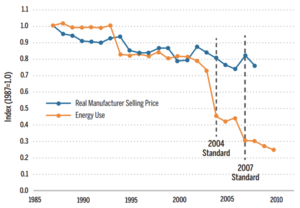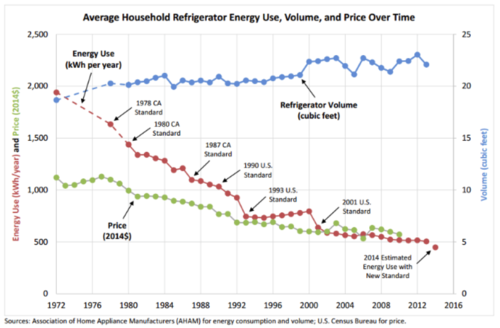Energy Efficiency Appliance and Equipment Standards Drive Savings, Innovation, and Consumer Choice

02/21/17
Energy Efficiency Appliance and Equipment Standards Drive Savings, Innovation, and Consumer Choice
Energy efficiency standards for appliances and other products are a practical and cost-effective tool for driving innovation, boosting economic activity, saving consumers money, and cutting pollution. The cost savings for consumers are immediate, and lifetime savings outweigh incremental costs by a ratio of 4 to 1. In fact, even as the U.S. has significantly improved efficiency standards, actual retail prices for appliances have fallen when adjusted for inflation.
Appliance Standards Support Innovation…
Energy efficiency standards help drive the innovation that creates greater consumer choices. Light bulbs are perhaps the most familiar example of how standards have stimulated innovation resulting in more consumer options in wattage, color, warmth, and other factors. Anyone browsing the light bulb aisle at the hardware store lately knows that consumers can now choose between halogen incandescent bulbs, compact fluorescent lamps (CFLs), or light-emitting diodes (LEDs)—and save 25% to over 75% on utility bills.

…And Keep Money in American Wallets
Of all the options for promoting sustainability in the home, improving efficiency is the single most economic and effective choice. Efficiency standards put more money in consumers’ pockets by helping them use less energy and lower electricity bills. A typical household saves about $320 per year as a result of current standards, and as people invest in newer, affordable models, they can expect to save nearly $460 annually by 2030. Since 2009, DOE has issued 40 new or updated appliance standards across more than 45 products. These standards alone will generate savings worth $447 billion.
Benefits of Standards Consistently Outweigh the Costs
 Fears of price increases for appliances due to new standards have consistently not come to pass. In fact, actual retail prices have fallen. The inflation-adjusted retail price of refrigerators, for example, decreased by about 35% between 1987 and 2010, along with clothes washers (by 45%) and dishwashers (by 30%)... Add to this the enormous environmental and public health benefits of avoiding nearly 4.5 trillion kilowatt-hours of power generation and the case for standards is clear.
Fears of price increases for appliances due to new standards have consistently not come to pass. In fact, actual retail prices have fallen. The inflation-adjusted retail price of refrigerators, for example, decreased by about 35% between 1987 and 2010, along with clothes washers (by 45%) and dishwashers (by 30%)... Add to this the enormous environmental and public health benefits of avoiding nearly 4.5 trillion kilowatt-hours of power generation and the case for standards is clear.Efficiency Standards Drive Market Expansion and Create Thousands of American Jobs
Industry supports efficiency standards because manufacturers want a level playing field, clear and predictable rules, and protection from unscrupulous foreign competitors. National efficiency standards were authorized by Congress for specific reasons, including manufacturers’ desire to minimize inconsistent state requirements. The most recent standard for commercial air conditioners and furnaces—which will save more energy than any other to date and deliver net consumer savings worth almost $50 billion—were negotiated and supported by manufacturers and efficiency advocates alike. Innovation from companies proves that there are boundless opportunities in the market, regardless of a company’s size. Efficiency standards are driving innovation and expanding existing markets, playing a key role in an overall energy efficiency industry that supports almost 2.2 million U.S. jobs.

STAY EMPOWERED
TAKE ACTION
Help the Alliance advocate for policies to use energy more efficiently – supporting job creation, reduced emissions, and lower costs. Contact your member of Congress.
JOIN US
Energy efficiency is smart, nonpartisan, and practical. So are we. Our strength comes from an unparalleled group of Alliance Associates working collaboratively under the Alliance umbrella to pave the way for energy efficiency gains.
DONATE
The power of efficiency is in your hands. Supporting the Alliance means supporting a vision for using energy more productively to achieve economic growth, a cleaner environment, and greater energy security, affordability, and reliability.



